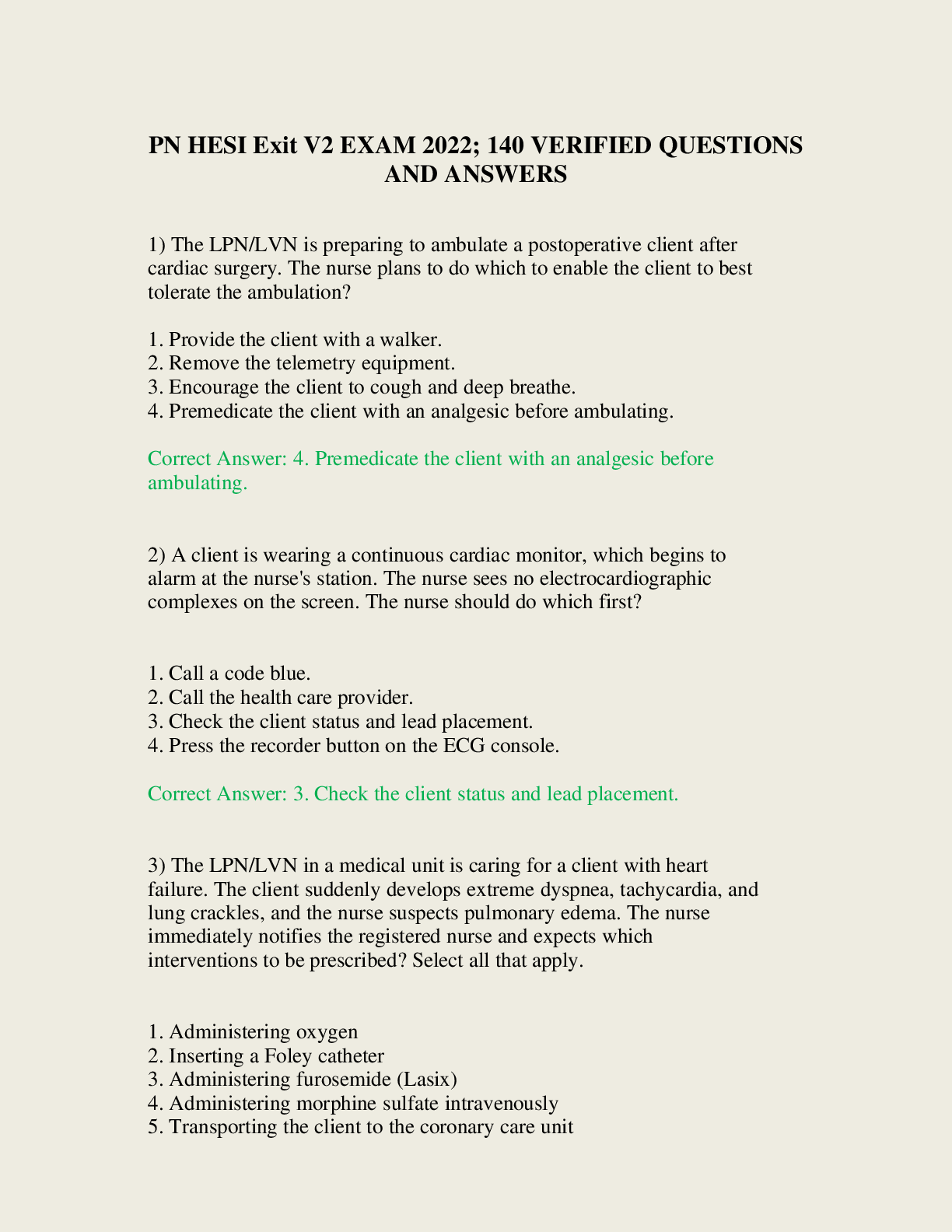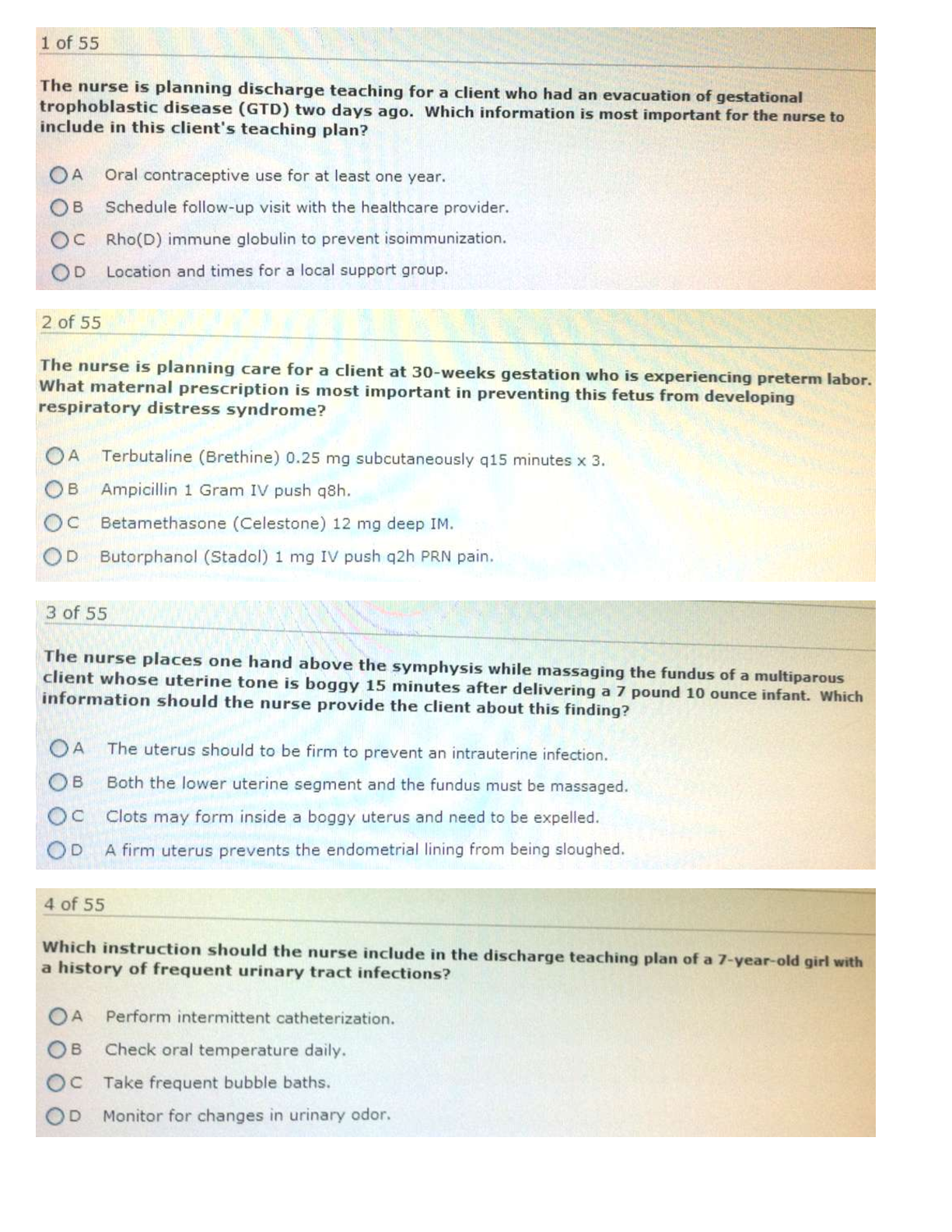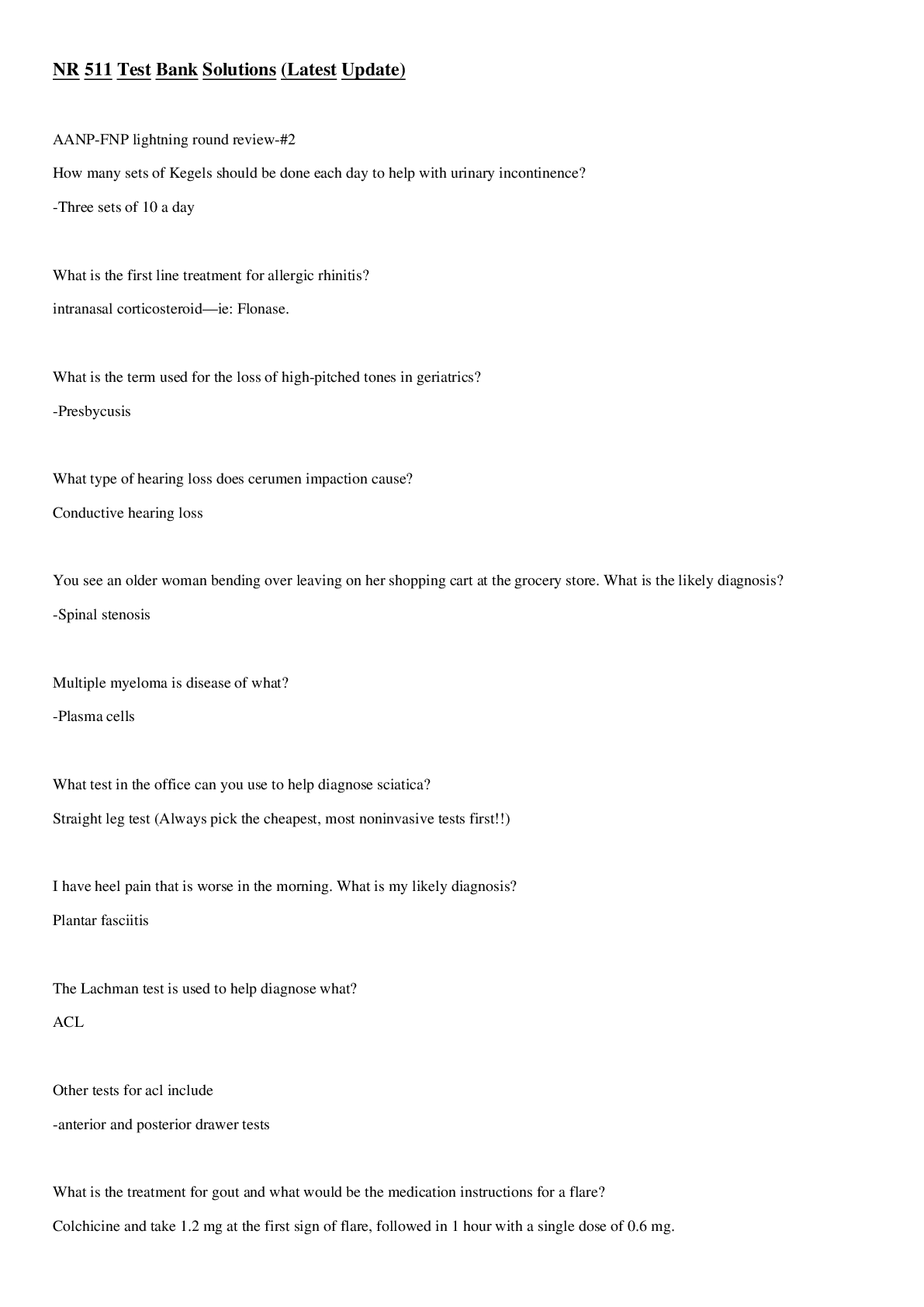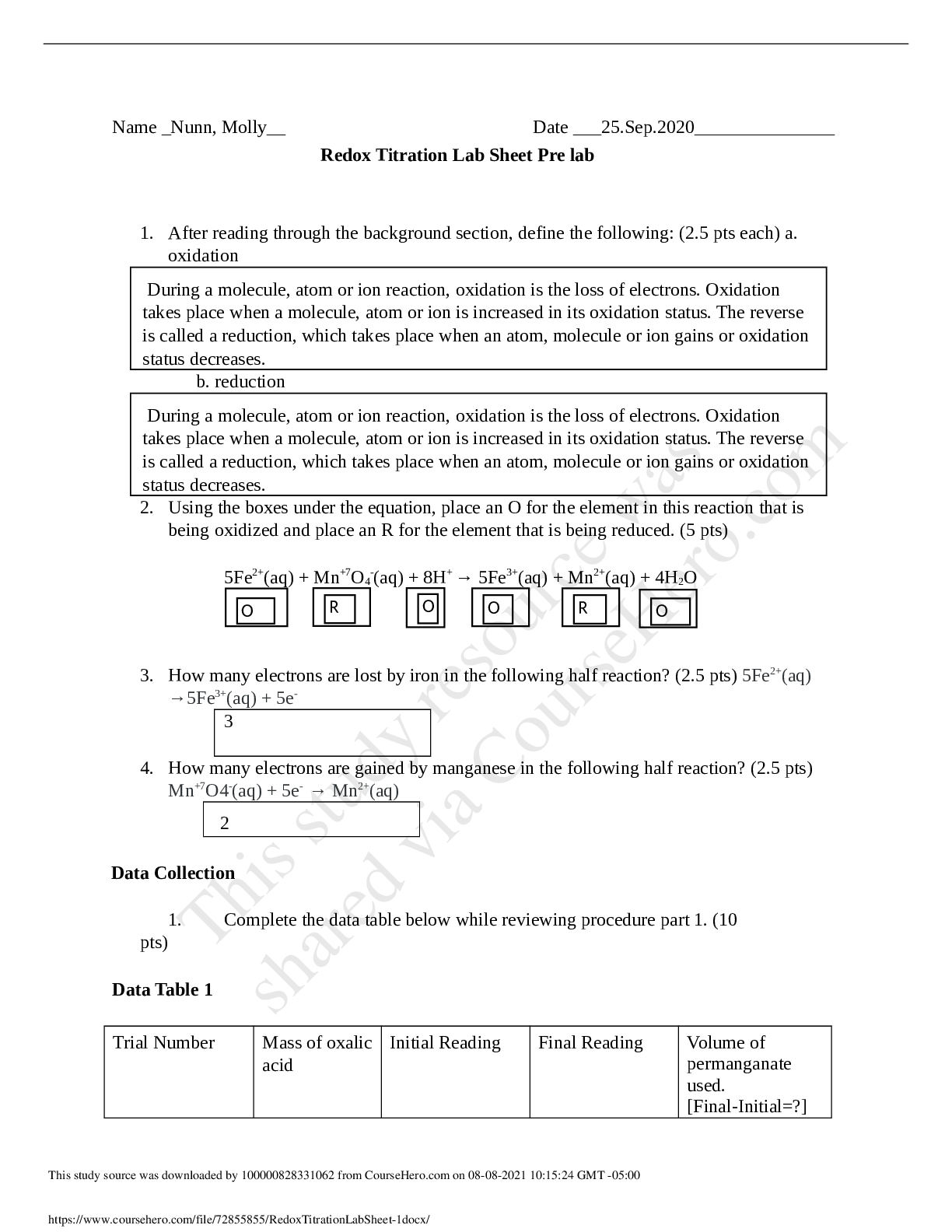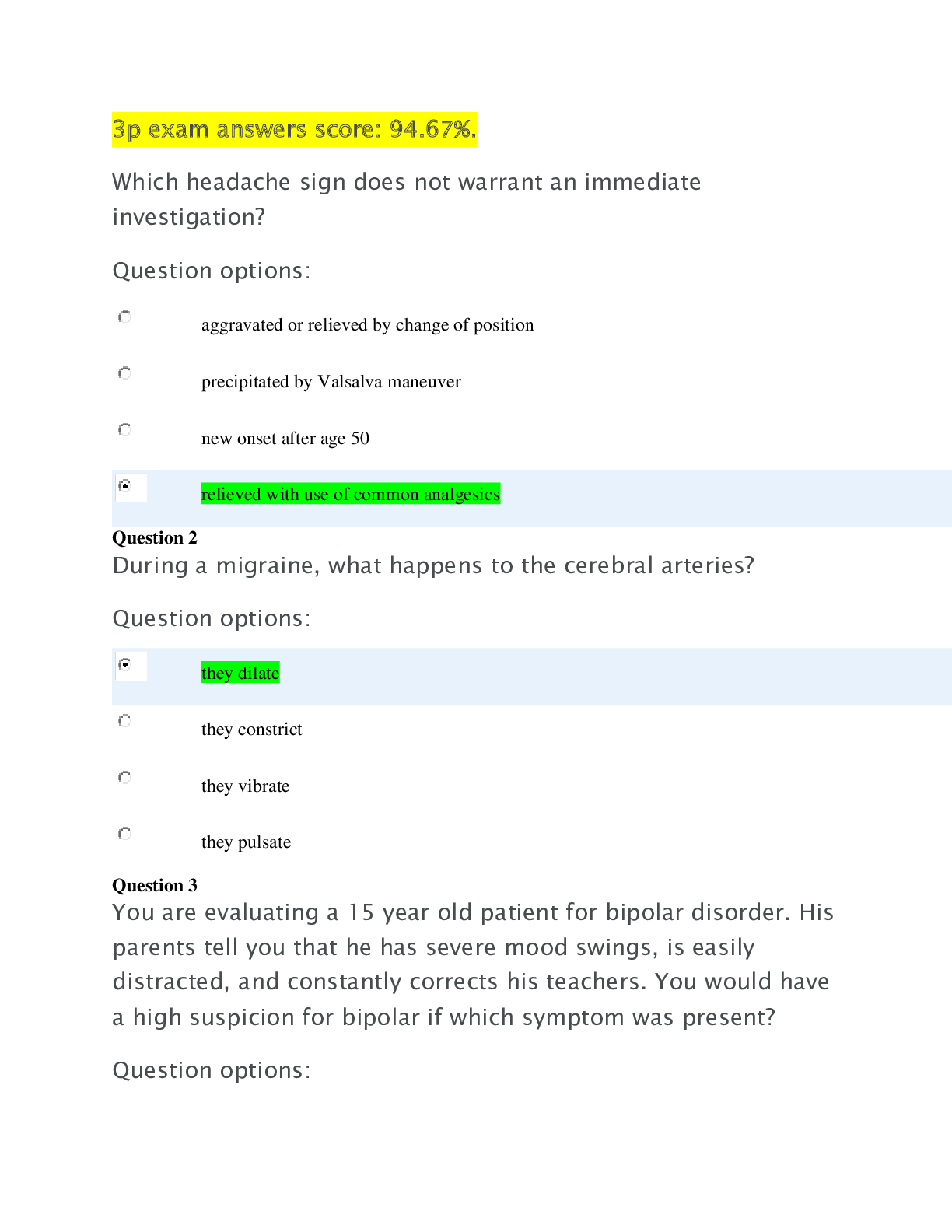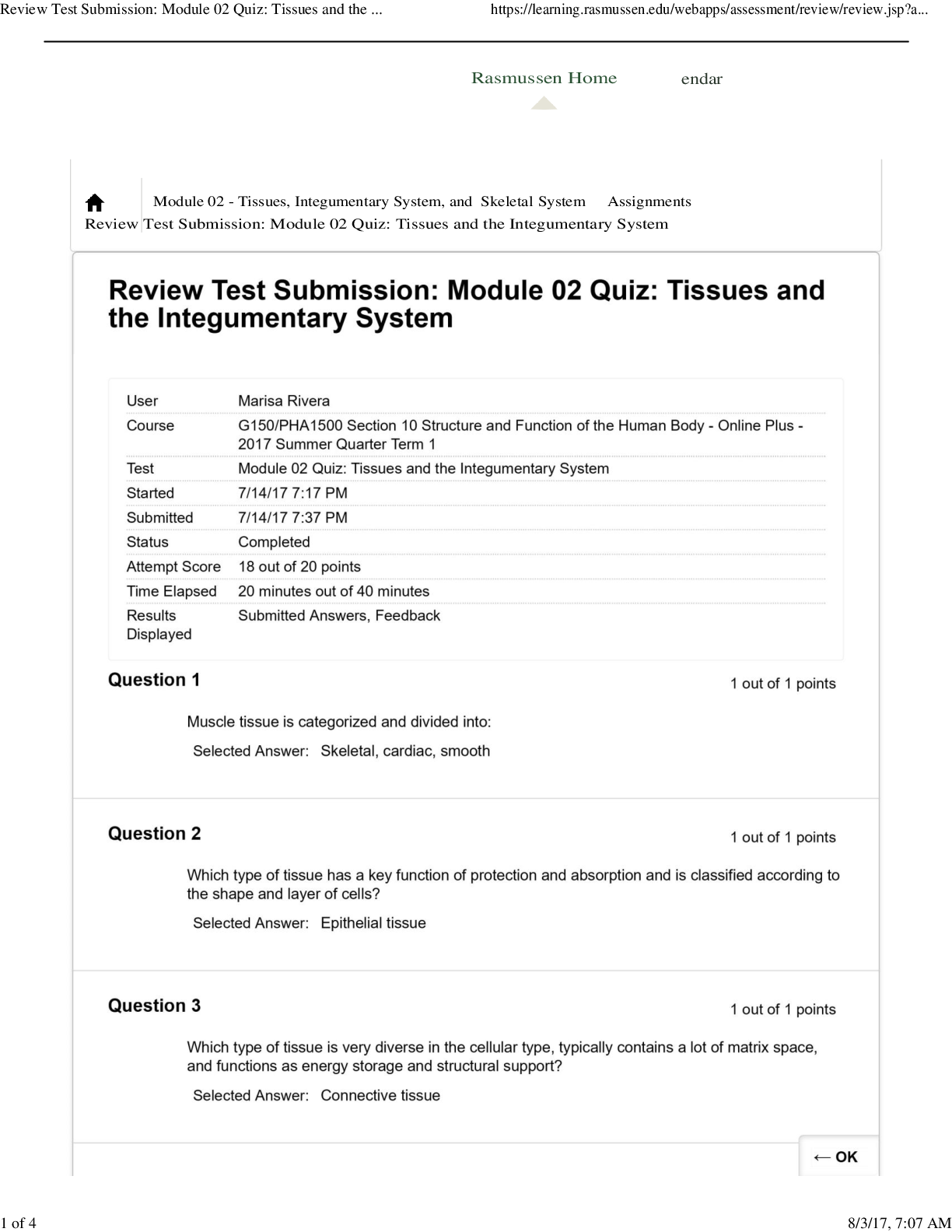Health Care > QUESTIONS & ANSWERS > HEALTHCARE BSC2347 bsc2347mod2casestudy Review Test Submission: Module 02 Case Study 100% Corrrect (All)
HEALTHCARE BSC2347 bsc2347mod2casestudy Review Test Submission: Module 02 Case Study 100% Corrrect
Document Content and Description Below
• Question 1 1 out of 1 points Rashidah is a 55-year-old female who is experiencing acute chest pain and shortness of breath. She describes the pain as “pressure and squeezing.” When she becomes... nauseous and light-headed, her son insists that he take her to the emergency room. Health History: She started smoking when she was 18, attempted to quit several times in her 40s, and had her last cigarette on her 50th birthday. She has been overweight for most of her adult life, but has gained 20 pounds in the last few years, which increased her BMI to 34. The last time she had a physical exam was when she turned 50. Her vital signs and blood test results from that exam are listed below. BP: 178/90 HDL: 62 mg/dl LDL: 190 mg/dl Triglycerides: 174 mg/dl Total cholesterol: 252 mg/dl Fasting blood glucose: 128 mg/dl Which of these statements is most likely correct? : Rashidah is experiencing a stroke. If Rashidah’s symptoms persist even when she rests, she is experiencing angina. Rashidah is likely experiencing a myocardial infarction. Since Rashidah’s symptoms are acute, she is likely suffering from a respiratory disorder. • Question 2 1 out of 1 points In the emergency room, multiple tests are performed. Which of these results would confirm myocardial damage? : Elevated troponin and creatine kinase Decrease myoglobin Elevated troponin and creatine kinase Elevated blood glucose levels Increase in WBC count • Question 3 0 out of 1 points Which of Rashidah’s physical exam lab test results was within normal limits for her age and sex? HDL LDL Total cholesterol Fasting blood glucose • Question 4 1 out of 1 points Given her last physical exam results, Rashidah’s physician believes she has likely had undiagnosed atherosclerosis for years. Briefly describe the pathophysiology of atherosclerosis. : Atherosclerosis is the buildup of plaque, which contains fats and cholesterol, on the inner layers of the arterial walls. Instead of being smooth and elastic, the layers become thickened and irregular with the lumen of the artery becoming narrower. This leads to reduced circulation of blood and can lead to elevated blood pressure. American Heart Association. (2017, November 17). Atherosclerosis: What role does cholesterol play? Retrieved from http://www.heart.org/HEARTORG/Conditions/Cholesterol/AboutCholesterol/Atherosclerosis_UCM_305564_Article.jsp#.W0dgJthKjMI • Question 5 1 out of 1 points Rashidah’s most recent Body Mass Index indicates that she is: : Obese Underweight Healthy Overweight Obese • Question 6 1 out of 1 points Which of the following statements is true? : Rashidah’s lab results and history tell us that she has Metabolic Syndrome. Rashidah’s heart attack was likely caused by a pulmonary embolism. Rashidah’s heart attack was likely unrelated to her history of smoking. Rashidah’s risk of a repeat heart attack is very low. • Question 7 1 out of 1 points A coronary angiography is performed and shows a complete blockage of the LAD. Briefly describe what this means. : LAD is the left anterior descending artery. It is the most important and often the largest of the 3 main arteries and it supplies the heart with the most blood. A blockage of the LAD artery is very serious because it does supply so much blood to the heart. Ahmed, Mustafa. (2015, February 11). The LAD Artery. Retrieved from https://myheart.net/articles/the-lad-artery/ • Question 8 1 out of 1 points Which of the following treatments would help correct Rashidah’s condition? : Surgical placement of a stent in the left descending artery Surgical repair of her aorta Mitral valve replacement Vitamin K supplementation • Question 9 1 out of 1 points Rashidah quit smoking 5 years ago, but still suffered a myocardial infarction. She is tempted to start smoking again since quitting “obviously didn’t make me healthier.” What does research tell us about her future health risks if she resumes smoking? : • Question 10 1 out of 1 points Before Rashidah is discharged from the hospital, she may experience stable angina, a form of chest pain, in the future. Briefly explain how angina is different from the pain associated with a myocardial infarction. : • Question 11 1 out of 1 points Roberto is a 78-year-old male who has recently been diagnosed with Class III Congestive Heart Failure (CHF). His physician told him that his left ventricle has become stiff and cannot relax. Although there is no current treatment that can “fix” Roberto’s condition, he is prescribed two medications- an ACE inhibitor and beta blockers. There are multiple types of CHF. Which of these types does Roberto have? : Diastolic heart failure Right-sided heart failure None of these choices is correct. • Question 12 1 out of 1 points Which of these statements is most likely true of Roberto’s current symptoms? : He has no symptoms at all during rest, but experiences palpitations, fatigues, and shortness of breath during mild exercise. He experiences fatigue, shortness of breath, and palpitations at rest and is not able to participate in any physical activity. • Question 13 1 out of 1 points Because of the dysfunction of Roberto’s left ventricle, which of these findings is most likely? : Decreased cardiac output End-diastolic volume is increased significantly Decreased diastolic pressure in the left ventricle Increase in stroke volume • Question 14 1 out of 1 points Briefly describe how beta-blockers will influence Roberto’s heart function, specifically the physiology of the ventricles. • Question 15 1 out of 1 points Briefly describe how ACE-inhibitors will influence Roberto’s heart function. • Question 16 1 out of 1 points Roberto’s doctor orders several tests of his heart function, including “ejection fraction.” Briefly explain what an ejection fraction measures. (Include what a normal measurement would be.) • Question 17 1 out of 1 points Which of the following conditions may have led to Roberto’s CHF? : All of these choices are correct. Faulty heart valves Hypertension Myocarditis Prior heart attacks • Question 18 1 out of 1 points Which of the following choices is NOT a risk factor for developing CHF? : History of leukemia Sleep apnea Obesity Heart arrhythmias • Question 19 1 out of 1 points Which heart valve opens to allow blood to leave the left ventricle? : Aortic valve Mitral valve Tricuspid valve Pulmonary valve • Question 20 1 out of 1 points Further testing reveals that Roberto has hypertrophy of the left ventricle. How does this finding relate to his diagnosis? [Show More]
Last updated: 1 year ago
Preview 1 out of 10 pages
Instant download

Buy this document to get the full access instantly
Instant Download Access after purchase
Add to cartInstant download
Reviews( 0 )
Document information
Connected school, study & course
About the document
Uploaded On
Jul 19, 2021
Number of pages
10
Written in
Additional information
This document has been written for:
Uploaded
Jul 19, 2021
Downloads
0
Views
51


